Answered step by step
Verified Expert Solution
Question
1 Approved Answer
Hi please help me accomplish this project. STEP 1 Implement new Obstacles module Please use your solution for the Toy Robot 4 exercise as starting
Hi please help me accomplish this project. 

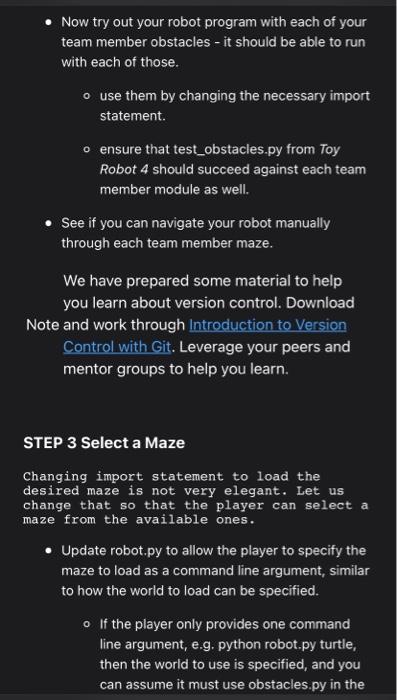
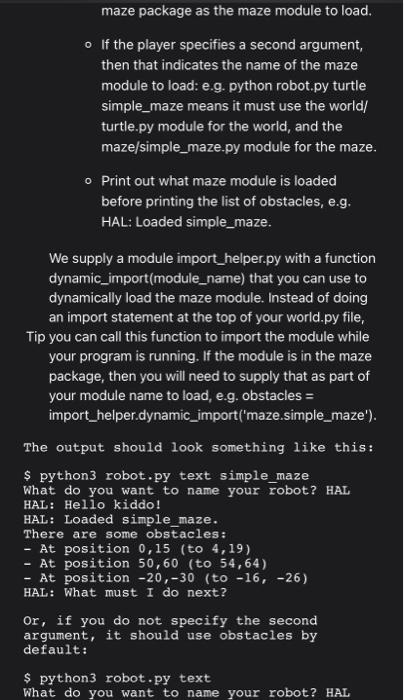
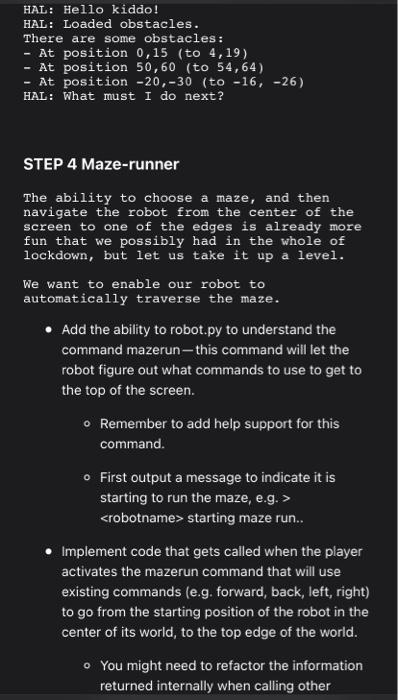

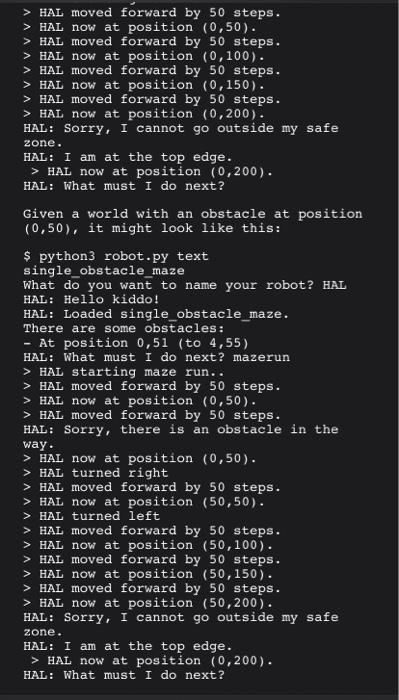
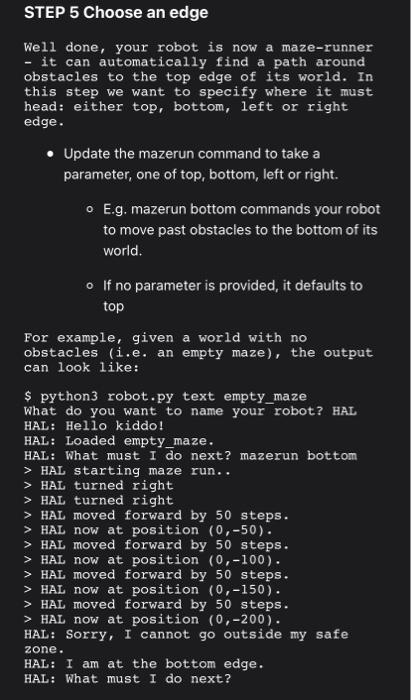
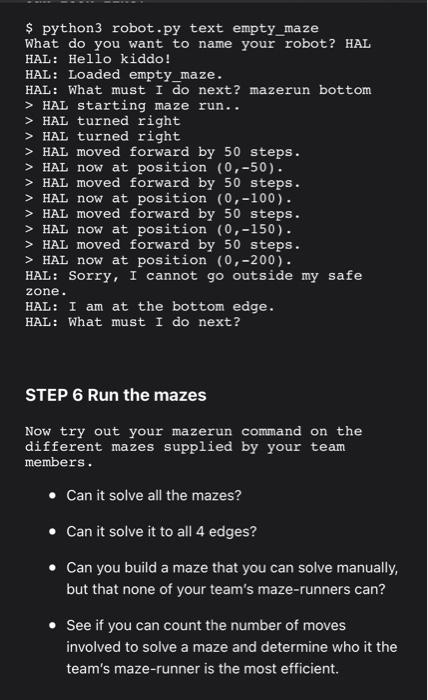
STEP 1 Implement new Obstacles module Please use your solution for the Toy Robot 4 exercise as starting point for this problem. First you need to implement your very own module, based on the obstacles.py module from the previous exercise, but with a better approach to generating obstacles so that it creates a kind of maze that is more difficult to navigate through. - First create a new package maze by creating it as a sub-directory. - Move your existing obstacles.py to that package, and update your existing code so that it imports obstacles from the maze package. - Now add a new module to the maze package with the same functions as in obstacles.py. - Use a descriptive filename for your maze code, e.g. the_worlds_most_crazy_maze.py - Change the implementation of the functions in your new module to create the obstacles in an interesting way. - First just create a few obstacles by hand and try that in your robot.py to see how it renders. Evolve using random obstacles, hard coded obstacles (for a hand-designed maze), or even look at interesting approaches like procedural generation - Use your new maze in your robot's world, and see how it works. - You are welcome to try out different maze implementations. - For now, just change the necessary import statements to choose which one to use. - Run your robot using the turtle world, so that you can visually see the maze and move through it manually. STEP 2 Share a maze Next you must share your maze implementation(s) with your team members. This is where a tool like git is handy, using a repository everyone can access, such as one hosted the WTC Gitlab. - Create a shared repository on GitLab, and make sure all team members have access to it - Clone that repository to your local machine, using a different working directory than this exercise directory. - Copy your maze python file(s) to that directory, and then use git to add it to the repository and push it to the remote repository. - Use git to pull the maze files of your team members from the repository. - Copy your team member maze files into this - Now try out your robot program with each of your team member obstacles - it should be able to run with each of those. o use them by changing the necessary import statement. o ensure that test_obstacles.py from Toy Robot 4 should succeed against each team member module as well. - See if you can navigate your robot manually through each team member maze. We have prepared some material to help you learn about version control. Download Note and work through Introduction to Version Control with Git. Leverage your peers and mentor groups to help you learn. STEP 3 Select a Maze Changing import statement to load the desired maze is not very elegant. Let us change that so that the player can select a maze from the available ones. - Update robot.py to allow the player to specify the maze to load as a command line argument, similar to how the world to load can be specified. - If the player only provides one command line argument, e.g. python robot.py turtle, then the world to use is specified, and you can assume it must use obstacles.py in the maze package as the maze module to load. - If the player specifies a second argument, then that indicates the name of the maze module to load: e.g. python robot.py turtle simple_maze means it must use the world/ turtle.py module for the world, and the maze/simple_maze.py module for the maze. - Print out what maze module is loaded before printing the list of obstacles, e.g. HAL: Loaded simple_maze. We supply a module import_helper.py with a function dynamic_import(module_name) that you can use to dynamically load the maze module. Instead of doing an import statement at the top of your world.py file, Tip you can call this function to import the module while your program is running. If the module is in the maze package, then you will need to supply that as part of your module name to load, e.g. obstacles = import_helper.dynamic_import('maze.simple_maze'). The output should look something like this: $ python 3 robot.py text simple_maze What do you want to name your robot? HAL HAL: Hello kiddo! HAL: Loaded simple_maze. There are some obstacles: - At position 0,15 (to 4,19 ) - At position 50,60 (to 54,64 ) - At position 20,30 (to 16,26 ) HAL: What must I do next? Or, if you do not specify the second argument, it should use obstacles by default: \$ python 3 robot.py text What do you want to name your robot? HAL HAL: Hello kiddo! HAL : Loaded obstacles. There are some obstacles: - At position 0,15 (to 4,19 ) - At position 50,60 (to 54,64 ) - At position 20,30 (to 16,26 ) HAL: What must I do next? STEP 4 Maze-runner The ability to choose a maze, and then navigate the robot from the center of the screen to one of the edges is already more fun that we possibly had in the whole of lockdown, but let us take it up a level. We want to enable our robot to automatically traverse the maze. - Add the ability to robot.py to understand the command mazerun - this command will let the robot figure out what commands to use to get to the top of the screen. - Remember to add help support for this command. - First output a message to indicate it is starting to run the maze, e.g. > > starting maze run.. - Implement code that gets called when the player activates the mazerun command that will use existing commands (e.g. forward, back, left, right) to go from the starting position of the robot in the center of its world, to the top edge of the world. - You might need to refactor the information returned internally when calling other command functions to provide enough information so that your maze-runner code can figure out what to do next. - E.g. each command function might need to be enhanced to return whether it could complete, or was obstructed, so you can use the information to determine if a next command should happen. - You might also need to add functionality to your world modules to indicate whether the current robot position is at a particular edge of the world. - For example, when calling forward, it might tell you there is an obstacle in the way, in which case your robot needs to rather go left or right. Try and put your maze-runner code in a separate module, and call that from robot.py Tip to solve the maze, using the returns from its functions to determine what commands to execute next. For example, given a world with no obstacles (i.e. an empty maze), the output can look like: $ python 3 robot.py text empty_maze What do you want to name your robot? HAL HAL: Hello kiddo! HAL: Loaded empty maze. HAL: What must I do next? mazerun > HAL starting maze run.. HAL moved forward by 50 steps. HAL now at position (0,50). HAL moved forward by 50 steps. HAL now at position (0,100). HAL moved forward by 50 steps. HAL now at position (0,150). HAL moved forward by 50 steps. HAL now at position (0,200). HAL: Sorry, I cannot go outside my safe zone. HAL : I am at the top edge. > HAL now at position (0,200). HAL: What must I do next? Given a world with an obstacle at position (0,50), it might look like this: \$ python 3 robot.py text single_obstacle maze What do you want to name your robot? HAL HAL: Hello kiddo! HAL: Loaded single_obstacle maze. There are some obstacles: - At position 0,51 (to 4,55 ) HAL: What must I do next? mazerun > HAL starting maze run.. > HAL moved forward by 50 steps. > HAL now at position (0,50). > HAL moved forward by 50 steps. HAL: Sorry, there is an obstacle in the way. > HAL now at position (0,50). > HAL turned Iight > HAL moved forward by 50 steps. > HAL now at position (50,50). > HAL turned left > HAL moved forward by 50 steps. > HAL now at position (50,100). > HAL moved forward by 50 steps. >HAL now at position (50,150). > HAL moved forward by 50 steps. > HAL now at position (50,200). HAL: Sorry, I cannot go outside my safe zone. HAL: I am at the top edge. > HAL now at position (0,200). HAL: What must I do next? STEP 5 Choose an edge Well done, your robot is now a maze-runner - it can automatically find a path around obstacles to the top edge of its world. In this step we want to specify where it must head: either top, bottom, left or right edge. - Update the mazerun command to take a parameter, one of top, bottom, left or right. - E.g. mazerun bottom commands your robot to move past obstacles to the bottom of its world. - If no parameter is provided, it defaults to top For example, given a world with no obstacles (i.e. an empty maze), the output can look like: \$ python3 robot.py text empty_maze What do you want to name your robot? HAL HAL: Hello kiddo! HAL: Loaded empty maze. HAL: What must I do next? mazerun bottom > HAL starting maze run.. > HAL turned right > HAL turned right > HAL moved forward by 50 steps. > HAL now at position (0,50). > HAL moved forward by 50 steps. > HAL now at position (0,100). > HAL moved forward by 50 steps. > HAL now at position (0,150). > HAL moved forward by 50 steps. > HAL now at position (0,200). HAL: Sorry, I cannot go outside my safe zone. HAL: I am at the bottom edge. HAL: What must I do next? \$ python 3 robot.py text empty_maze What do you want to name your robot? HAL HAL: Hello kiddo! HAL: Loaded empty_maze. HAL: What must I do next? mazerun bottom > HAL starting maze run.. > HAL turned right > HAL turned right > HAL moved forward by 50 steps. > HAL now at position (0,50). > HAL moved forward by 50 steps. > HAL now at position (0,100). > HAL moved forward by 50 steps. > HAL now at position (0,150). > HAL moved forward by 50 steps. > HAL now at position (0,200). HAL: Sorry, I cannot go outside my safe zone. HAL: I am at the bottom edge. HAL: What must I do next? STEP 6 Run the mazes Now try out your mazerun command on the different mazes supplied by your team members. - Can it solve all the mazes? - Can it solve it to all 4 edges? - Can you build a maze that you can solve manually, but that none of your team's maze-runners can? - See if you can count the number of moves involved to solve a maze and determine who it the team's maze-runner is the most efficient 








Step by Step Solution
There are 3 Steps involved in it
Step: 1

Get Instant Access to Expert-Tailored Solutions
See step-by-step solutions with expert insights and AI powered tools for academic success
Step: 2

Step: 3

Ace Your Homework with AI
Get the answers you need in no time with our AI-driven, step-by-step assistance
Get Started


